- COURSES
- SPECIALS
- BLOG
- MEMBERS
- SHOP
- ABOUT
- ENROLL HERE
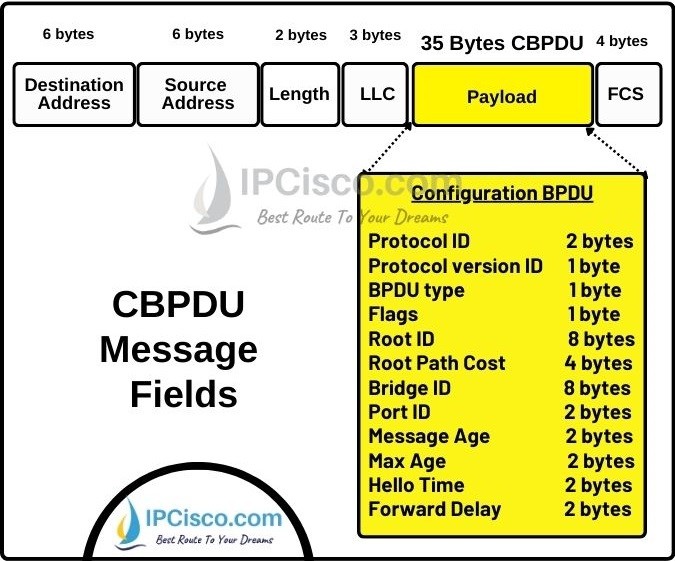
Bridge Protocol Data Units (BPDUs) are the messages used in a switching domain which allow switches to gather information about other switches and participate in Spanning Tree Protocol (STP). They are the key messages used in an STP topology. In this CCNA lesson, we will focus on BPDUs, we will learn what is BPDU and why we use these messages in switching. We will also go through the types of switches.
Table of Contents
BPDU (Bridge Protocol Data Unit) is basically a message which carries information about the switches. With these messages switches gather information about other switches and participate in STP (Spanning Tree Protocol).
In a Local Area Network (LAN), in STP domain, some messages are shared between switches for a loop free switching. With these messages, each switch sends its information to the other switches. The name of these messages are Bridge Protocol Data Units. In other words, in an STP domain, switches send Bridge Protocol Data Units to inform other switches about themselves and also learn about other switches via these messages, Bridge Protocol Data Units.
Test Yourself With CCNA Practice Questions!
Bridge Protocol Data Units are mainly used for the messaging between switches. With this messaging, it provides a loop free layer 2 domain by preventing broadcast storms. Sometimes they are used to exchange topology information and sometimes they are used inform the other devices about the topologyt change in STP topology.
BPDU messages contains information about switches. This information is about Switch ID, Switch Port, MAC Address, Port priorities, port costs etc. Below, you can find the details of these information for different types of Bridge Protocol Data Units.
A switch sends Bridge Protocol Data Units from their original port to a multicast destination MAC address 01:80:c2:00:00:00. After receiving these messages, each switch does the STP calculations to determine redundant ports. After doing this it shuts down these ports to prevent any layer 2 loop. The algorithm used for this calculation is Spanning Tree Algorithm (STA).
01-80-C2-00-00-00 is one of the MAC addresses that are allocated by IEEE. IEEE is allocated the block from 01-80-C2-00-00-00 to 01-80-C2-FF-FF-FF for group addresses used by standard network protocols. These MAC group addresses are not forwarded.
In IEEE 802.1D STP, there are two types of Bridge Protocol Data Units. These BPDU types are given below:
CBPDU (Configuration BPDU) are Bridge Protocol Data Units that are sent to exchange topology information between switches in STP domain. At the initialization stage, each switch in the STP domain sends Configuration BPDUs. By doing this, root bridge election is also done. After that, in normal state, each designated port sends this type of BPDUs periodically.
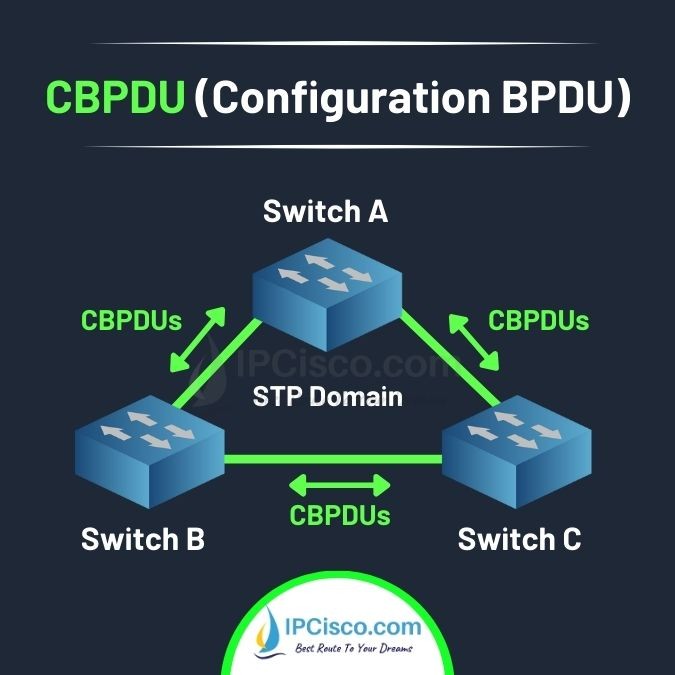
Configuration BPDU Topology
CBPDU (Configuration BPDU) is sent at the initialization to exchange topology information. After that they are sent to inform periodically.
Bridge Protocol Data Unit information is in the payload part of a layer 2 frame. If it is a CBPDU, the below information is sent in this payload part. These are given below:
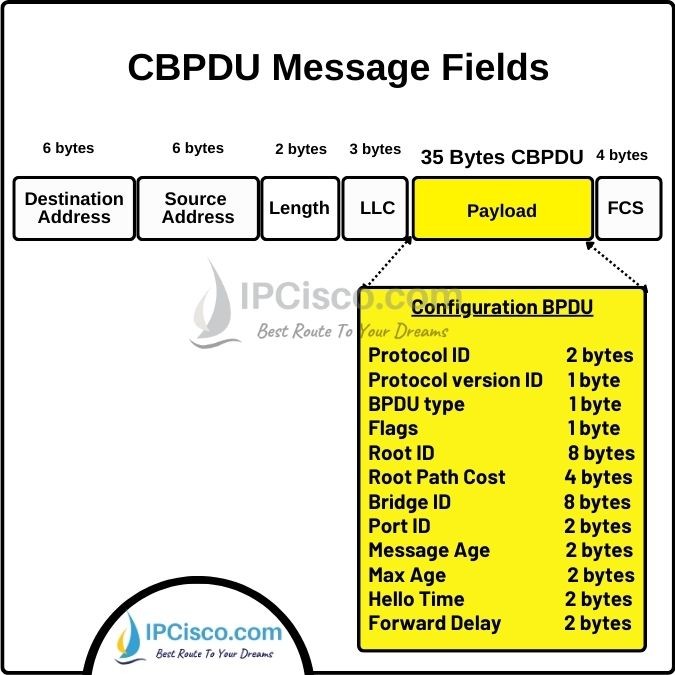
Configuration BPDU Message Fields
Protocol ID is the fixed part as 0x0000 for IEEE 802.1d.
Protocol version ID is the version of STP, for STP it is 0x00.
BPDU type is the type of Bridge Protocol Data Unit. For Configuration BPDU, this field is 0x00.
Flags give the purpose of Bridge Protocol Data Unit. It indicates that whether the network topology has changed or not. It is 8 bits. The lowest bit is Topology Change (TC) bit. The highest bit is Topology Change Acknowledgement (TCA) bit. The other bits are reserved.
Root ID is the BID for the current root bridge which is formed by the priority and MAC address of the root bridge.
Root Path Cost is the cost of the path through root bridge
Bridge ID is the designated bridge’s ID which sends the Bridge Protocol Data Unit. It is formed by the priority and MAC address of the designated bridge.
Port ID is the designated port ID formed by the priority and global port number of the designated port.
Message Age is the age time while BPDU is propagated in the network.
Max Age is the maximum age time that Bridge Protocol Data Unit is stored at that device.
Hello Time is the time for Bridge Protocol Data Unit transmission interval.
Forward Delay is the delay of a port during listening and learning states.
TCN (Topology Change Notification) are BPDUs that are sent by switches in STP domain to inform the devices about any topology changes in the topology. Non-root bridges send these Bridge Protocol Data Units.
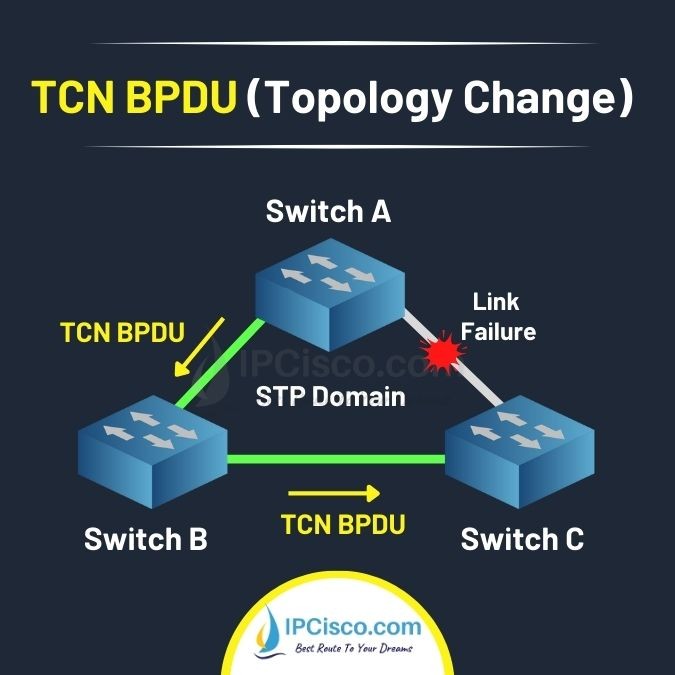
TCN BPDU Topology
TCN BPDUs are sent whenever a topology change occurs in the STP domain in local area network. These topology change can be related with a port status change from up to down or down to up. Or it can be related with no BPDU receiving for a while. During such problems, some ports go from forwarding or learning states to blocking and some of them goes from blocking to forwarding. Whatever it is, this is a topology change and this change must be sent to the root bridge via TCN BPDU.
BPDU information is in the payload part of a layer 2 frame. If it is a TCN BPDU, there are three information is sent in this payload part. These are given below:
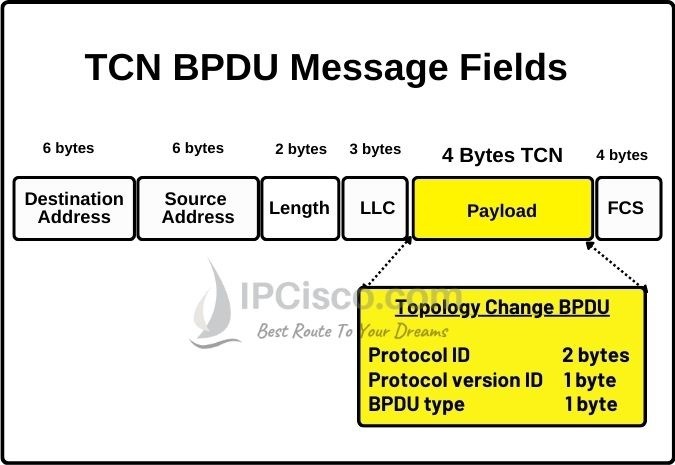
TCN BPDU Message Fields
Protocol ID is the fixed part as 0x0000 for IEEE 802.1d.
Protocol version ID is the version of STP, for STP it is 0x00.
BPDU type is the type of Bridge Protocol Data Unit. For TCN Bridge Protocol Data Unit, this field is 0x80.
Leave a Reply